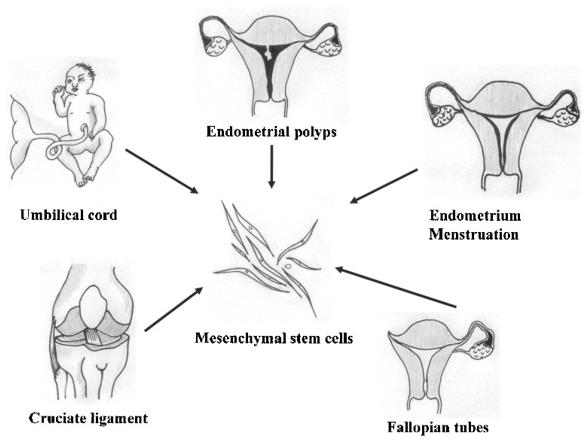Mesenchymal Stem Cells: A Comprehensive Exploration
Stem cells possess two key features: the ability to differentiate along various lineages and the ability to self-renew. Two primary types of stem cells have been identified: embryonic stem cells and adult stem cells. Embryonic stem cells (ESCs) are derived from the inner cell mass of the blastocyst and are associated with tumorigenesis. The use of human ESCs raises ethical and legal concerns. The use of adult mesenchymal stem cells is less problematic in this regard. Mesenchymal stem cells (MSCs) are stromal cells capable of self-renewal and multilineage differentiation.
Biology and Characteristics of Mesenchymal Stem Cells
The biology and characteristics of MSCs encompass a range of unique features that contribute to their therapeutic potential and versatility.
- Multipotency and self-renewal capacity. One of the hallmark characteristics of MSCs is their multipotency, which refers to their capacity to differentiate into multiple cell lineages, including osteoblasts (bone cells), adipocytes (fat cells), and chondrocytes (cartilage cells). Additionally, MSCs exhibit self-renewal capabilities, allowing them to proliferate and maintain their undifferentiated state over extended periods, making them an abundant and sustainable cell source for therapeutic applications.
- Surface markers and immunophenotype. MSCs are defined by the expression of specific surface markers and the absence of others. Common positive markers include CD73, CD90, and CD105, while they lack expression of hematopoietic markers such as CD45, CD34, CD14, or CD11b. The distinct immunophenotype of MSCs serves as a crucial criterion for their identification and isolation from tissue sources.
- Immunomodulatory properties. MSCs possess remarkable immunomodulatory properties, allowing them to interact with and regulate various components of the immune system. These cells can suppress the proliferation and function of T cells, modulate the activity of B cells, influence the maturation of dendritic cells, and affect the cytotoxicity of natural killer cells. The intricate interplay between MSCs and immune cells highlights their potential to mitigate inflammatory responses, ameliorate autoimmune disorders, and promote tolerance in allogeneic transplantation.
- Extracellular vesicles and paracrine signaling. In addition to their direct cellular activities, MSCs secrete a variety of bioactive molecules, growth factors, and extracellular vesicles that contribute to their therapeutic effects. These paracrine signaling mechanisms enable MSCs to exert cytoprotective, anti-inflammatory, and regenerative effects within damaged or diseased tissues.
Sources of Mesenchymal Stem Cells
Sources of MSCs play a pivotal role in their accessibility, abundance, and potential applications in regenerative medicine and research. Various tissues serve as reservoirs for MSCs, each offering distinct advantages and considerations for their isolation and utilization.
 Fig. 1 Various new sources of MSCs. (Vignali DA and Kuchroo VK, 2012)
Fig. 1 Various new sources of MSCs. (Vignali DA and Kuchroo VK, 2012)
- Bone marrow-derived MSCs. Bone marrow has been a traditional and well-studied source of MSCs. Bone marrow-derived MSCs exhibit robust multipotency and the capacity to differentiate into various cell lineages. Despite being an invasive source, bone marrow offers the advantage of yielding a relatively high number of MSCs.
- Adipose tissue-derived MSCs. Adipose tissue represents a rich and accessible source of MSCs, with the added benefit of minimally invasive harvesting procedures. Adipose tissue-derived MSCs are abundant and have demonstrated therapeutic potential in tissue repair and regeneration.
- Umbilical cord tissue-derived MSCs. Umbilical cord tissue is a valuable reservoir of MSCs with unique properties such as primitive characteristics and low immunogenicity, making them an appealing source for allogeneic transplantation and regenerative therapies.
- Dental pulp-derived MSCs. Dental pulp represents a rich source of MSCs with regenerative and immunomodulatory properties. Dental pulp-derived MSCs have been investigated for their potential in dental tissue engineering, craniofacial reconstruction, and neurological repair. These cells offer an accessible and ethically uncontroversial source of MSCs, making them particularly attractive for translational research.
Differentiation of Mesenchymal Stem Cells
MSCs can differentiate into various lineages of mesodermal, ectodermal, and endoderm such as bone, fat, chondrocyte, muscle, neuron, islet cells, and liver cells under specific in vitro conditions. Differentiation is also regulated by genetic events, involving transcription factors. MSCs can differentiate into a variety of specialized cell types, including:
- Mesoderm: osteoblasts, chondrocytes, adipocytes, cardiomyocytes
- Ectoderm: neuronal cells
- Endoderm: hepatic, pancreatic, respiratory epithelial cells
Creative Bioarray Relevant Recommendations
- Creative Bioarray provides advanced and experienced MSC services covering all stages of MSC development, including isolation, expansion, characterization, and differentiation.
- We offer a broad range of mesenchymal stem cell products including cryopreserved human and animal MSCs from various tissue sources, optimized media for expansion and cryopreservation, kits and media to differentiate the cells into adipocytes and osteocytes, and characterization antibodies and kits.
| Cat. No. | Product Name |
| CSC-00859L | Human Placental Mesenchymal Stem Cells |
| CSC-00873L | Human Peripheral Blood-Derived Mesenchymal Stem Cells |
| CSC-00874L | Human Synovial Mesenchymal Stem Cells |
| CSC-C8006L | Human Mesenchymal Stem Cells |
| CSC-00424L | Rabbit Bone Marrow Mesenchymal Stem Cells |
| CSC-00791L | Aged Mouse Bone Marrow Mesenchymal Stem Cells |
| CM-1153X | SuperCult® Mesenchymal Stem Cell Osteogenic Differentiation Medium Kit |
| CM-1154X | SuperCult® Mesenchymal Stem Cell Neurogenic Differentiation |
Explore our full range of MSCs to find what you need!
Reference
- Ding DC, et al. (2011). "Mesenchymal stem cells." Cell Transplant. 20 (1), 5-14.